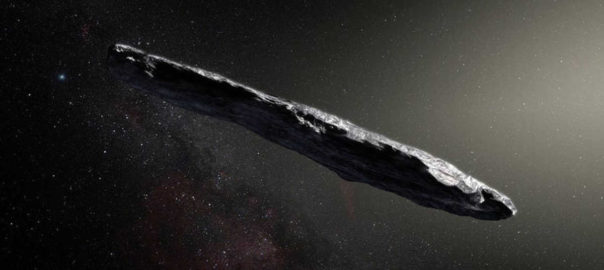By Kent R. Kroeger (Source: NuQum.com; November 9, 2018)
Despite headlines suggesting two scientists concluded an alien ‘probe’ — nicknamed Oumuamua, meaning “a messenger that reaches out from the distant past” in Hawaiian — may have recently entered (and left) our solar system, the researchers actually came to the exact opposite conclusion.
A big thumbs down for today’s science journalism.
Oumuamua, a cigar-shaped object observable from Earth for only a few days, was seen to enter and leave our solar system in a manner quite different from previous solar system intruders. Whereas previous objects, such as comets, followed a Keplerian orbit indicative of objects under our Sun’s gravitational influence, Oumuamua was under some other intragalactic object’s gravitational influence. Or, perhaps, Oumuamua was moving under its own power, as would an alien spacecraft or probe. The two scientists at the Harvard Smithsonian Center for Astrophysics lightheartedly posed the question (and quickly dismissed it) in their paper published in Astrophysical Journal Letters.
Nonetheless, their research paper does lay out the argument for why we cannot instinctively dismiss the possibility that aliens will someday visit our planet.
One inference I made from the Astrophysical Journal Letters paper was that, if our planet is visited by an alien civilization, it will most likely be through one of their interstellar probes and not directly by the aliens themselves.
Keeping a living, biological entity alive for what would be an interminably long trip — most likely taking hundreds of years — is just not practical and probably not necessary, unless this alien culture is in the process of colonizing another planet. Let us hope that is not their ultimate motivation when their first probe arrives here.

The layman argument for why aliens will arrive (probably in the next few hundred years)
To start the conjecture process, accept these three broad assumptions:
(1) Advanced-intelligence alien civilizations exist within 250 light-years of our planet and the number of such civilizations is not less than 100. Given that there are 260,000 stars within 250 light-years of our own, that would translate to at least one advanced civilization for every 2,600 stars.
(2) Among these advanced-intelligence civilizations, humans are average in intelligence and technological advancement.
(3) And finally, like Earthlings, aliens have a powerful drive to explore beyond their own planet.
The net result of these assumptions is the expectation that they will contact us, should one of these alien civilizations know we exist and live relatively close by (say, within a few hundred light-years).
But how will they contact us?
Our own experience helps answer this question. Human civilization organized beyond mere tribal and local congregations is only five- to ten-thousand years old, not even the wink-of-an-eye in astronomical terms. And, yet, in that short time, we’ve moved from simple wheeled-carts to interplanetary probes. We’ve even sent probes that have left our solar system.
However, leaving the solar system is nothing compared to visiting an exoplanet (i.e., a planet outside our solar system). But we’ve taken the first big step in this process. Humans can now observe other exoplanets, some as close as a few light-years away (Ross 128b is only 11 light-years away and possibly life-supporting). We know the composition of their atmospheres and what the temperatures are like between day and night and at different moments in the exoplanet’s orbit.
Humans are rapidly compiling a list of “nearby” exoplanets most likely to support advanced, intelligent life. The list is not long, but it is not zero either.
If humans are doing this, intelligent aliens are doing it too. Yes, I only have a sample size of one, but as noted, I assume humans are average among the advanced-intelligence lifeforms in our galactic quadrant.
Therefore, I expect half of the advanced-intelligence civilizations are far beyond observing and categorizing exoplanets and are much closer than ourselves in identifying specific exoplanets where advanced life exists.
Once identified, there are two options: Send messages to this exoplanet or travel there directly, most likely via an interstellar probe.
The advantage of sending messages is that those will travel at light-speed. If the target is 10 light-years away, it will only take 20 years to complete the first conversational exchange, assuming the target receives and understands the message.
Frankly, it is much more logical to travel there straightaway and avoid the improbabilities of starting a constructive long-distance relationship.
To do that, however, requires fast spacecrafts. Super fast. As in, a significant-percentage-of-light-speed type of fast.
Currently, the fastest outward-bound human-built spacecraft, Voyager 1, has traveled 1/600 of a light-year in 30 years and is currently moving at 1/18,000 the speed of light. At that speed, it would take Voyager 1 over 80,000 years to reach the nearest star, Alpha Centauri C, a red dwarf about four light-years from Earth.
We must go much faster to reach a nearby exoplanet in any reasonable amount of time.
The good news is, we already know theoretically how human-built probes might achieve fast space transport in the near distant future: lightsails using nanotechnology harnessing the power of lasers.
Lightsails are large sheets of reflective material that are propelled forward by photons (rather than wind as in the case of ocean ship sails). Laser arrays based on earth will supply the propulsive power.
Using technologies that still need to be developed but are theoretically possible, scientists believe these lightsail-equipped probes could achieve 20 percent of light-speed — that is over 200 kilometers per hour. At this speed, human probes would reach Alpha Centauri C in 20 years and the exoplanet Ross 128b in under 60 years.
If that is what humans are relatively close to doing, imagine what a significantly more advanced civilization has already achieved. One of the conjectures offered about Oumuamua was that it was powered by a lightsail system (retracted by the time it arrived in our solar system).
Even at 20 percent of light-speed, 60 years to reach a nearby exoplanet represents slightly more than a scientist’s career span (~40 years). It is possible to imagine an advanced civilization would readily make such an attempt once the technological challenges and cost factors were adequately addressed.
It is possible such preparations to visit Earth are about to get underway and, if so, we can be near certain of these following facts:
(1) Their arrival will not be a case of random chance. Aliens are right now observing the third planet from our Sun, a big blue ball situated conveniently within the Goldilocks orbital zone — the ideal location for abundant, advanced lifeforms. We are being watched by ‘people’ only hundreds of light-years away from us.
(2) By observation and measurement, they know we have lots of liquid water and an atmosphere composed mostly of nitrogen and oxygen. They will know that this environment is a likely breeding ground for life, even if their own biological existence is based on some other, yet unknown, alternative basis for life.
(3) There is no reason to assume we are the only planet in this small section of our Milky Way galaxy with these life-friendly characteristics, but our Earth may have a distinguishing characteristic unlike any other life-conducive planet: We have been broadcasting our existence for nearly 100 years now, and doing it with significant and consistent power for about 50 years. Now, chances are excellent our future alien visitors have not yet observed our unique electromagnetic signature, so we can’t assume that this Earth feature has aided their decision on where to visit. Still, it is possible our unique signature could help the aliens decide on visiting us first.
(4) Even if they don’t ‘hear’ us, our big yellow Sun will set us apart from other exoplanet candidates for alien visitation.
(5) Our new alien friends will probably be from a red dwarf star system (the most common in the galaxy) where initial conditions are not as conducive to advanced, intelligent life as offered by our warm Sun. Earth’s home star has kept our nights cool but life-supporting and our days quite pleasant. We haven’t had to struggle in the way our alien visitors most likely will have experienced.
(6) That means advanced lifeforms may have taken longer to initially develop on their home planet, but once they did, their significant environmental challenges probably pushed their intellectual and technological achievement along a steeper, higher development curve.
In other words, when our new alien friends do arrive, they are probably going to consider us fat, lazy and stupid. Hopefully, they will find our big, drippy eyes cute enough to save us from immediate extermination, but make no assumptions in that regard.
In fact, once the alien probe arrives, humans will have many decisions to make.

The first decision is to decide who among us will make the first contact with the probe. In most movie versions of first contact, its the scientists who make the discovery but the military that coordinates humanity’s response. If it were me, I’d leave the initial contact entirely in the hands of scientists, and make sure the diplomats, politicians and military leaders are kept as far away from our visitors as possible.
Why scientists? Because of all the aforementioned groups, scientists will best understand and appreciate the enormous effort it took for this alien civilization to traverse the vast emptiness of space to arrive here on earth.
Of course, we will all want to know if their arrival is hostile or purely exploratory in its intent. And, frankly, it could be a mixture of motivations, some friendly and some not so much.
But even before we can discern intent, we must determine what exactly is visiting us. Is it actual aliens? A probe? A planet-killing weapon? Are they looking for a new homeland? That determination will not be easy.
Assuming the probe offers little information and is not capable of communicating with us (which is likely), we must still try to understand its origin and technological features. Again, only scientists are going to have the relevant knowledge to make such a determination.
And once all that is done. We sit and wait. If the probe has actually landed on the Earth’s surface, we may at some point try to carefully dissect it. Or, if the probe plants itself in orbit around the Earth, we would send our own satellites or manned spacecraft to observe the probe more closely.
In the end, our first contact with an alien civilization might be somewhat of a letdown, particularly if it is a mechanized probe with no engineered capability to communicate with us.
Still, an alien civilization probing our solar system would psychologically be one of the most monumental events in human history. Oumuamua’s brief appearance in our solar system was not that event, but it was a vivid reminder to me that it could happen…nay, it will happen.
- K.R.K.

